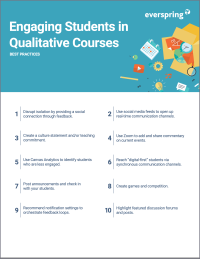Search
There are 9 results.
Tag
Tag
All (62)
Active Learning (4)
Activities (3)
Analytics (4)
Assessments (6)
Asynchrony (5)
Backwards Design (1)
Canvas (7)
Case Studies (1)
Collaboration (3)
Communication (7)
Community (5)
Content Creation (12)
Course Maintenance (4)
Course Materials (3)
Course Preparation (4)
Discussions (4)
Faculty Presence (8)
Faculty Support (2)
Feedback (4)
Formative Assessments (5)
Game-Based Learning (2)
Gamification (1)
Generative AI (5)
Grading (3)
Images (1)
Multimodality (7)
Qualitative courses (1)
Quantitative courses (1)
Revising (2)
Rubrics (1)
Social Media (1)
Synchrony (6)
Third-Party Tools (1)
Universal Design for Learning (UDL) (1)
Video (1)
Visual Design (1)
First Time Teaching Online
The online learning environment may seem vastly different from the on-ground classroom. With the right preparation, however, you can successfully translate on-ground teaching and expertise into the online modality and create an engaging learning experience for students. In this piece, we will walk through things you’ll want to look for and decisions you’ll need to make when teaching online for the first time, regardless of what course you’re teaching. Additionally, we also provide some specific examples that are particularly relevant if you are using the Canvas learning management system.
Leveraging CSV Downloads
The majority of an online instructor’s course facilitation will occur within the learning management system (LMS). However, there are some tasks that can be improved or streamlined by downloading comma-separated value (CSV) files from Canvas. Running an online course requires balancing a lot of names, assignments, and deadlines, so using Microsoft Excel, Google Sheets, or another spreadsheet software can assist with course management.
Canvas Grading and Feedback: What Students See
Did you know that some forms of assignment feedback in Canvas are more obvious to students than others? Canvas has a Student View option for instructors to get a sense of what students are seeing in most general areas of their courses, but it can be challenging to determine what your actual students are experiencing when accessing your comments on their work or the rubric you’ve filled out for their submission.
Choosing Tech
“How do I choose the right technology?” is a common question in education, and in online program development in particular, where it is usually asked in the context of building an online course or other virtual learning experience. After all, the subject matter expert and instructional designer are hoping to create an experience for students that is both meaningful and valuable. Knowing how to orchestrate content and pedagogy is already hard enough, but add in the fact that there are thousands of technology options, and the task can feel even more daunting.
Taking Stock at the Midpoint of the Term
Halfway through the term isn't a great time to change around a bunch of materials or assignments in your course. However, it is a useful moment to evaluate how the course is going, realign to match the goals you set out at the beginning of the term, and determine what you may be able to tweak to make your course work more effectively for you and for your students. This piece suggests actions you can take at midterm to help shape the second half of the course.
Five Ways to Succeed as an Online Instructor
Whether experienced in or new to online teaching, following these tips on online instruction can make the process more intuitive. The online environment may seem vastly different from the classroom, but these tips will make it feel natural, allowing you to improve student experience, increase teaching efficacy, cultivate engagement, and ensure successful course management.









